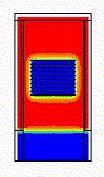PHOENICS FOR CHEMICAL VAPOR DEPOSITION (CVD)
Crystal Growth Modeling

Cutaway diagram of a Jipelec-type CVD reactor used for Si deposition from silane. Contours show silane concentration near the symmetry plane, and silicon deposition rate on the wafer.
PHOENICS-CVD has been used to simulate:
- Single-wafer cold-wall silane reactor
- Shower-head reactor; tungsten deposition
- Plasma-enhanced silicon deposition
- 12-wafer reactor; tungsten deposition
- Fraunhofer IIS-B; steady temperature distribution
- Fraunhofer IIS-B; transient temperature distribution
- Silicon nitride formation in a hot wall batch reactor
- Tungsten deposition in a single wafer, cold-wall reactor
- Polysilicon growth in an RTP reactor
- Plasma-enhanced deposition of amorphous silicon
- Polysilicon single wafer reactor processes
- Metalorganic deposition of titanium nitride
- SiO2 deposition in a commercial reactor.
Complete Design and Analysis Tool for CVD Reactors
Simulation is used to improve the design of CVD equipment, to reduce the need for prototyping and to answer the "what if" questions of engineers.
Using the PHOENICS-CVD software system engineers can:
- optimize CVD reactor design
- tune process parameters to improve yield
- explore new processes before equipment is purchased
- troubleshoot poorly operating processes and equipment
Features
PHOENICS-CVD is an integrated software system designed to simulate the behavior of a wide range of CVD reactors; this involves the modeling of fluid flow and heat transfer in a multi-component gas, including both gas-phase (homogeneous) and surface (heterogeneous) chemical reactions and incorporating plasma effects.
Implementation is by means of a graphical, menu-driven, object-orientated interface, coupled with a library of generic reactor designs providing an easy route to problem set-up and modification.
PHOENICS-CVD offers:
- Simulation of steady-state or transient (process start-up and shut-down) behavior
- Cartesian, Polar or Body-Fitted-Coordinate grids
- Multi-component diffusion and gas properties with a choice of models
- Thermal diffusion with a choice of options
- Gas and surface chemical reactions, with built-in options and the provision for user- coding if required
- Surface-to-surface radiation
- Plasma modeling using an effective drift-diffusion model
- Data files for transport, thermodynamic, material, optical and chemical reaction parameters
Download Technical Description
Validation
PHOENICS-CVD has been validated for a range of CVD processes. The development and experimental verification of PHOENICS-CVD are documented in over 20 publications; Contact us for copies.
[peekaboo_link name="car1"]Contact Sales[/peekaboo_link]
[peekaboo_content name="car1"]
Thank you for your interest in our products and services.
if you would like to speak to a Sales Representative about Phoenics CVD, please fill out the following form:
[/peekaboo_content]
